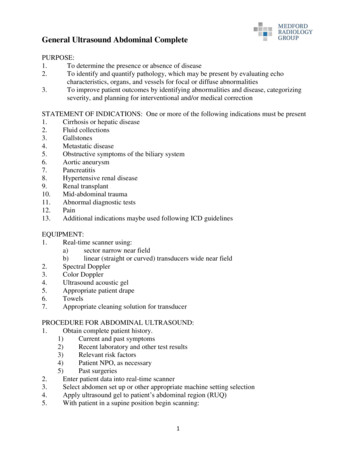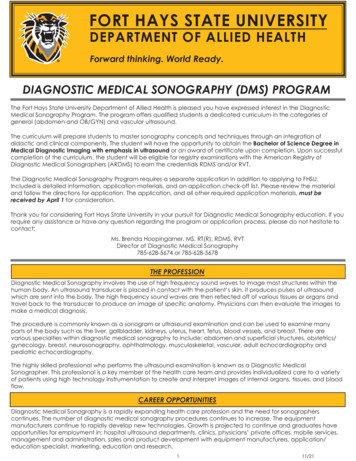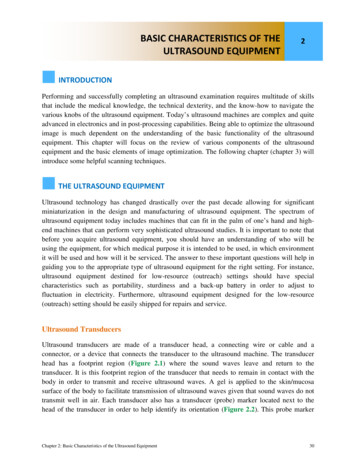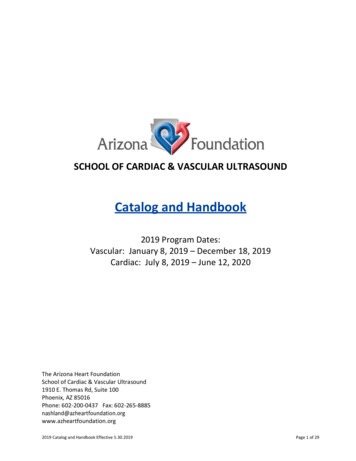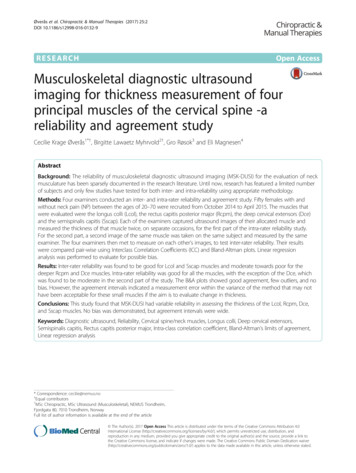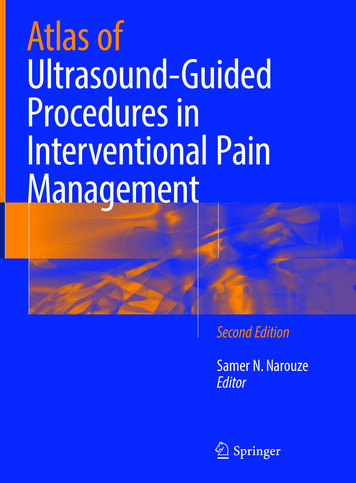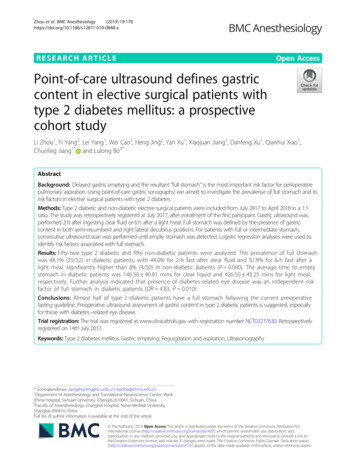
Transcription
Zhou et al. BMC Anesthesiology(2019) EARCH ARTICLEOpen AccessPoint-of-care ultrasound defines gastriccontent in elective surgical patients withtype 2 diabetes mellitus: a prospectivecohort studyLi Zhou1, Yi Yang2, Lei Yang1, Wei Cao2, Heng Jing2, Yan Xu1, Xiaojuan Jiang1, Danfeng Xu1, Qianhui Xiao1,Chunling Jiang1* and Lulong Bo3*AbstractBackground: Delayed gastric emptying and the resultant “full stomach” is the most important risk factor for perioperativepulmonary aspiration. Using point-of-care gastric sonography, we aimed to investigate the prevalence of full stomach and itsrisk factors in elective surgical patients with type 2 diabetes.Methods: Type 2 diabetic and non-diabetic elective surgical patients were included from July 2017 to April 2018 in a 1:1ratio. The study was retrospectively registered at July 2017, after enrollment of the first participant. Gastric ultrasound wasperformed 2 h after ingesting clear fluid or 6 h after a light meal. Full stomach was defined by the presence of gastriccontent in both semi-recumbent and right lateral decubitus positions. For patients with full or intermediate stomach,consecutive ultrasound scan was performed until empty stomach was detected. Logistic regression analyses were used toidentify risk factors associated with full stomach.Results: Fifty-two type 2 diabetic and fifty non-diabetic patients were analyzed. The prevalence of full stomachwas 48.1% (25/52) in diabetic patients, with 44.0% for 2-h fast after clear fluid and 51.9% for 6-h fast after alight meal, significantly higher than 8% (4/50) in non-diabetic patients (P 0.000). The average time to emptystomach in diabetic patients was 146.50 40.91 mins for clear liquid and 426.50 45.25 mins for light meal,respectively. Further analysis indicated that presence of diabetes-related eye disease was an independent riskfactor of full stomach in diabetic patients (OR 4.83, P 0.010).Conclusions: Almost half of type 2 diabetic patients have a full stomach following the current preoperativefasting guideline. Preoperative ultrasound assessment of gastric content in type 2 diabetic patients is suggested, especiallyfor those with diabetes -related eye disease.Trial registration: The trial was registered at www.clinicaltrials.gov with registration number NCT03217630. Retrospectivelyregistered on 14th July 2017.Keywords: Type 2 diabetes mellitus, Gastric emptying, Regurgitation and aspiration, Ultrasonography* Correspondence: jiangchunling@scu.edu.cn; bartbo@smmu.edu.cn1Department of Anesthesiology and Translational Neuroscience Center, WestChina Hospital, Sichuan University, Chengdu 610041, Sichuan, China3Faculty of Anaesthesiology, Changhai Hospital, Naval Medical University,Shanghai 200433, ChinaFull list of author information is available at the end of the article The Author(s). 2019 Open Access This article is distributed under the terms of the Creative Commons Attribution 4.0International License (http://creativecommons.org/licenses/by/4.0/), which permits unrestricted use, distribution, andreproduction in any medium, provided you give appropriate credit to the original author(s) and the source, provide a link tothe Creative Commons license, and indicate if changes were made. The Creative Commons Public Domain Dedication o/1.0/) applies to the data made available in this article, unless otherwise stated.
Zhou et al. BMC Anesthesiology(2019) 19:179IntroductionGastric emptying is known to be delayed in patients withdiabetes mellitus [1, 2]. Approximately 30–50% of patientswith longstanding diabetes mellitus have significantly prolonged gastric emptying time, as measured by radioisotopeexamination [3, 4]. Delayed gastric emptying and the resultant “full stomach” is the most important risk factor forperioperative regurgitation and aspiration, which remainsa common, disastrous complication with high morbidityand mortality in patients undergoing general anesthesia.Consequently, American Society of Anesthesiologists(ASA) released preoperative fasting guidelines for healthypatients undergoing elective surgery [5], in order to reducegastric content volume and minimize the risk of aspiration. However, there are still many situations where theASA fasting guidelines may be not suitable, including urgent or emergency situations and medical conditions, e.g.,diabetes mellitus, which is associated with delayed gastricemptying.Recent studies have shown that ultrasound examination can be used for the accurate assessment of gastricvolume and content with high intra- and inter-rater reliability in healthy subjects [6–8], surgical patients [9],and others [10, 11]. As a novel point-of-care application,ultrasound sonography allows anesthesiologists to evaluate a patient’s gastric content and volume at the bedside,and helps guide anesthetic and airway management [12–14]. We hypothesize that ultrasound sonography will behelpful to determine the gastric content in elective surgical patients with type 2 diabetes mellitus.Using this non-invasive technique for the assessmentof gastric content, we aimed to determine the prevalenceof full stomach following the present fasting guidelinesin elective adult surgical patients with type 2 diabetesmellitus, and to investigate associated risk factors for delayed gastric emptying, in this prospective cohort study.Materials and methodsAfter obtaining Ethics approval (Ethical Committee N 2017–141) from the Ethical Committee of West ChinaHospital, Chengdu, China (Chairperson Prof MZ. Liang)on 16 June 2017, we conducted this prospective cohortstudy in West China hospital according to the principlesexpressed in the Declaration of Helsinki from July 2017 toApril 2018. The study was retrospectively registered atJuly 2017, after enrollment of the first participant. Type 2diabetic and non-diabetic patients admitted to the surgicaldepartment were screened and recruited to participate inthe study. Inclusion criteria were as follows: type 2 diabetic (two fasting plasma glucose concentration 7 mmol/L or casual plasma glucose concentration 11.1 mmol/Lwith classic symptoms of hyperglycemia) [15] or nondiabetic patient; age 18 yr; ASA physical status I-III;body mass index (BMI) 35 Kg/m2; elective surgery; bePage 2 of 9able to understand the rationale of the study and provideinformed consent. Exclusion criteria were as follows: pregnancy; a history of upper gastrointestinal disease or previous surgery on the esophagus, stomach or upperabdomen; documented abnormalities of the upper gastrointestinal tract such as gastric tumors; recent uppergastrointestinal bleeding (within the preceding 1 month);taking medicines that may delay gastric emptying (e.g.,anticholinergic agents, opioid); hypothyroidism. Writteninformed consent was obtained from all included subjects.Eligible type 2 diabetic and non-diabetic subjects wererecruited in a 1:1 ratio. Subjects in both groups werefasted overnight (at least 10 h) from the last meal. Afterenrollment, patients will be randomized to ingesting either clear fluid or light meal (a standardized portion ofnoodles or toast, and clear fluid). Randomization wasperformed using computer-generated random numbersand group assignments were delivered in sealed, opaqueenvelopes. An attending anesthesiologist, who had an experience with at least 100 gastric ultrasound examinations previously, performed all ultrasound examinationsin the study. The anesthesiologist was blinded to groupallocation or the history of the participants. Ultrasoundexaminations were carried out 2 h after ingesting clearfluid or 6 h after a light meal, according to preoperativefasting guidelines by ASA released in early 2017 [5].Ultrasound examinationUltrasound examinations were conducted with a lowfrequency (2-5 MHz) curvilinear array probe from a Philips (CX50) (Bothell, WA, USA). As previously described[16], a sagittal cross-section of the antrum in a plane including the left lobe of the liver anteriorly, and the pancreas and aorta posteriorly was acquired. All quantitativeand qualitative examinations were performed in thesemi-recumbent and then the right lateral decubitus(RLD) positions. A three-point grading scale describedby Perlas was used for the qualitative assessment: Grade0, no gastric content was detected in antrum in eithersemi-recumbent or RLD position (Fig. 1a); Grade1, thegastric content was detected in the RLD only; Grade2,the content was detected in both semi-recumbent andRLD positions (Fig. 1b – Fig. 1c) [17]. For the quantitative assessment, the antral cross-sectional area (CSA)was calculated as follows [18]: measuring the anteriorposterior (D1) and cranio-caudal diameters (D2) of theantrum at antral resting, from serosa to serosa, using theformula: Antral cross-sectional area D1 D2 π/4.Ultrasound examinations were conducted with a lowfrequency curvilinear array probe from a Philips (CX50)(Fig. 1), showing an empty gastric antrum (a), liquid (b)and semi-solid(c) food in the gastric antrum. A sagittalcross-section of the antrum in a plane, including the leftlobe of the liver anteriorly, the pancreas and aorta
Zhou et al. BMC Anesthesiology(2019) 19:179Page 3 of 9Fig. 1 Sonographic image of the gastric antrum in the semi-recumbent position. Ultrasound examinations were conducted with a low-frequencycurvilinear array probe from a Philips (CX50), showing an empty gastric antrum (a), liquid (b) and semi-solid (c) food in the gastric antrum. A sagittalcross-section of the antrum in a plane, including the left lobe of the liver anteriorly, the pancreas and aorta posteriorly was acquired. A, antrum; L, liver;P, pancreas; SA, splenic artery; SV, splenic vein; Ao, aorta; SMV, superior mesenteric veinposteriorly was acquired. A, antrum; L, liver; P, pancreas;SA, splenic artery; SV, splenic vein; Ao, aorta; SMV, superior mesenteric vein.The stomach was considered as empty in either PerlasGrade 0 regardless of the CSA, or Grade 1 with CSA 340 mm2. Intermediate stomach contents were definedas Grade 1 with CSA 340 mm2. A full stomach that increases risk of pulmonary aspiration of gastric contentsin the event of general anesthesia was defined as Grade2 regardless of CSA [2, 17].For patients with full or intermediate stomach, consecutive ultrasound scan was performed every 10 minuntil empty stomach were detected. The antral crosssectional area (CSA) was measured and recorded at eachexamination.Patient characteristic data were recorded for analysis,including age, sex, Body Mass Index (BMI), ASA physical status classification, and scores of Self-Rating Anxiety Scale (SAS), fasting duration (defined as the timebetween the fluid or light meal ingestion and ultrasoundexamination), comorbidities, and surgery scheme. Otherrelevant data, including the postprandial plasma glucoseconcentration, hemoglobin A1c level and the diabetescomplications, e.g., peripheral neuropathy defined asscores of Michigan Neuropathy Screening Instrument 2 [19], cardiovascular autonomic neuropathy definedusing the American Diabetes Association criteria andthe Toronto Consensus Panel on Diabetic Neuropathy[20], diabetic nephropathy, and diabetes mellitus-relatedeye disease (including diabetic retinopathy, macularedema, rubeosis iridis, vitreous hemorrhage and diabeticrelated-visual injury) [21], were recorded for analysis, aswell.The primary outcome was the prevalence of full stomach in diabetic elective surgical patients. The secondaryoutcome was the gastric emptying time of clear liquidsand light meal in diabetic patients. Using logistic regression analyses we examined the risk factors associatedwith full stomach.Sample size and statistical analysisBased on the original data from our preliminary study andother study, the estimated occurrence of full stomach was40% in diabetic patients, and 6.2% in elective surgical patients [22]. Thus, twenty-four patients per group would beexpected to detect a significant difference with a type 1error 0.05 and a power of 80%. Taking into account adrop-out rate of about 10%, we originally plan to enroll 54patients (27 in each group) to compare the incidence offull stomach. In order to investigate the risk factors for fullstomach, we enlarged sample size to 108 patients formultivariate logistic regression analysis in our study (54patients in each group). Statistical analysis was performedwith SPSS 21.0(IBM Corp; Armonk, New York, USA).After a Shapiro-Wilk test for normality of data distribution,continuous data (i.e., age, BMI, plasma glucose concentration, and hemoglobin A1c level) were expressed as themean SD for normally distributed data, or median [interquartile range] for non-normally distributed data. The normally distributed continuous data were analyzed by student’stest and the non-normally distributed data were analyzed byWilcoxon Rank Sum Test. Chi-square test or Fisher exacttest were performed to compare incidence data (i.e., the percentage of co-morbidities, Perlas grade and the incidence offull stomach). Two-tailed tests will be used in all statisticalanalysis, and P value of less than 0.05 will be considered tobe of statistical significance.Univariate logistic regression analysis was used toidentify variables associated with a full stomach, described as odds ratios (OR) with 95% confidence interval(CI). All variables that differed between groups (P 0.05)together with the related-factors reported in previousstudies were entered into a multivariate logistical regression analysis to investigate the risk factors for delayedgastric emptying in diabetic patients.ResultsOne hundred and eight patients admitted for electivesurgery were enrolled in this study: 54 type 2 diabetic
Zhou et al. BMC Anesthesiology(2019) 19:179Page 4 of 9Fig. 2 Flow chart and patients included in this studypatients and 54 non-diabetic controls. Two diabetic andfour non-diabetic subjects were withdrawn from thestudy because of inability to localize the antrum. Finally,102 patients (52 type 2 diabetic and 50 non-diabetic patients) completed the study and were included in thefinal analysis (Fig. 2), with the dropout rate at 5.56%.There were no significant differences in age, sex, ASAphysical status and BMI between diabetic and nondiabetic patients, except that the SAS scores were higherin diabetic patients, whereas both were lower than 40(SAS score anxiety 40 defined as anxiety) [23]. Themain surgical plans for patients included were as follows:urological surgery (23.5%), gynecological surgery(27.5%), orthopedics surgery (11.8%) and others (37.2%),and no significant differences were observed betweentwo groups (Table 1).As shown in Table 2, type 2 diabetic patients have ahigher prevalence of full stomach when compared tonon-diabetic patients (48.1% vs. 8.00%, P 0.000), whichis 44.0% vs. 8.0% (P 0.000) for 2-h fast after clear fluidand 51.9% vs. 8.0% (P 0.000) for 6-h fast after a lightmeal, respectively.Table 1 Patients baseline characteristicsP-valueDiabetic patient (n 52)Non-diabetic patient (n 50)60.67 10.3460.25 10.390.299Body mass index (Kg.m )24.24 2.8322.34 2.920.489Sex (Female/male)29/2330/200.665I0 (0%)12 (24.0%)II50 (96.1%)36 (72.0%)III2 (3.9%)2 (4.0%)Cardiovascular disease33 (63.5%)32 (64.0%)Cerebrovascular disease4 (7.7%)6 (12.0%)Obesity#5 (9.6%)5 (10.0%)28.75 6.0124.54 4.12Age (yr) 2ASA physical status*0.968Co-morbidities*Scores of Self-Rating Anxiety ScaleData are given as mean SD unless otherwise indicated* Data are given as number (percentage of patients)ASA American Society of Anesthesiologists# Defined by body mass index 280.4790.001
Zhou et al. BMC Anesthesiology(2019) 19:179Page 5 of 9Table 2 Quantitative and qualitative gastric ultrasound examinationClear liquid & light mealDiabetic patientNon-diabetic patientn 52n 50Perlas grade0.00006 (11.5%)16 (32.0%)121 (40.4%)30 (60.0%)225 (48.1%)4 (8.0%)37 (71.2%)25 (50.0%)Empty stomach13 (25.0%)32 (64.0%)Intermediate stomach14 (26.9%)14 (28.0%)Full stomach25 (48.1%)4 (8.0%)n 25n 25Antral cross-sectional area 340 mm2 (Right lateral decubitus)IndicationClear liquid0.00003 (12.0%)10 (40.0%)111 (44.0%)13 (52.0%)211 (44.0%)2 (8.0%)18 (72.0%)10 (40.0%)Empty stomach5 (20.0%)15 (60.0%)Intermediate stomach9 (36.0%)8 (32.0%)Full stomach11 (44.0%)2 (8.0%)n 27n 25IndicationLight meal0.00003 (11.1%)6 (24.0%)110 (37.0%)17 (68.0%)20.0230.000Perlas grade14 (51.9%)2 (8.0%)19 (70.4%)15 (60.0%)Empty stomach6 (22.2%)17 (68.0%)Intermediate stomach7 (25.9%)6 (24.0%)Full stomach14 (51.9%)2 (8.0%)Antral cross-sectional area 340 mm2 (Right lateral decubitus)0.0290.000Perlas gradeAntral cross-sectional area 340 mm2 (Right lateral decubitus)P-valueIndication0.4320.000Data are given as number (percentage of patients)For patients with full or intermediate stomach followingfasting guidelines (39 diabetic and 18 non-diabetic), consecutive ultrasound examination was performed every 10 minuntil empty stomach was detected. The average time toempty stomach was significantly longer in type 2 diabetic patients than that of non-diabetic patients, being 146.50 40.91mins vs. 124.50 10.68 mins (P 0.014) after ingesting clearliquids and 426.50 45.25 mins vs. 370.00 53.97mins (P 0.042) after light meal, respectively.In order to investigate the risk factors for full stomachin diabetic patients, we further divided diabetic patientsinto full stomach group and empty/intermediate stomach group based on gastric ultrasound grade and performed a subgroup analysis. The baseline characteristics(age, sex, BMI and scores of self-rating anxiety scale)showed no significant difference between subgroups.The median duration of diabetes were 6 years (IQR [2–10 yr]), and the treatment medicine for diabetes showedno significant difference between subgroups. Interestingly, the prevalence of diabetes mellitus-related eye disease was higher in patients with full stomach afterrecommended fasting duration, than those with emptyor intermediate stomach (52.0% vs. 22.2%, P 0.026).However, the incidence of peripheral neuropathy andcardiovascular automonic neuropathy showed no significant difference between groups, and none of the patientshad diabetic nephropathy (Table 3). Further univariateanalysis showed that diabetes-related eye disease was significantly associated with full stomach (OR 4.83, P 0.010), while we did not find any association of age,
Zhou et al. BMC Anesthesiology(2019) 19:179Page 6 of 9Table 3 Diabetic patients’ characteristics between those with full stomach and empty/intermediate stomachP-valueCharacteristicFull stomach (n 25)Empty/intermediate stomach (n 27)Age (yr)62.21 10.2758.83 10.880.553Body mass index (Kg.m 2)24.34 3.1923.79 2.930.563Sex (Female/male)13/1214/130.991Scores of Self-Rating Anxiety Scale28.74 5.8228.26 6.250.800Fasting glucose (mmol/L)7.88 2.797.80 2.400.921Postprandial glucose (mmol/L)10.50 4.0510.69 2.480.861Hemoglobin A1c (%)7.5 1.77.3 1.60.861Diabetic nephropathy0 (0%)0 (0%)–Peripheral neuropathy*6 (24.0%)6 (22.2%)0.879Cardiovascular autonomic neuropathy *18 (72.0%)18 (66.7%)0.677Diabetes mellitus-related eye disease*13 (52.0%)6 (22.2%)0.026Data are given as mean SD unless otherwise indicated*Data are given as number (percentage of patients)Hemoglobin A1c, peripheral neuropathy, and cardiovascular autonomic neuropathy with full stomach. After adjusted by age, sex, BMI and SAS scores, diabetes-relatedeye disease was shown to be an independent risk factorof full stomach (Table 4).DiscussionThis prospective study showed that almost half of the type2 diabetic patients with a median duration of 6 years had afull stomach following the current preoperative fastingguideline, and the average time to empty stomach statefor diabetic patients is 146.50 40.91 mins for clear liquids and 426.50 45.25 mins for light meal, longer thanthe recommended fasting duration of ASA [5]. Furthermore, we found patients with diabetes mellitus-related eyedisease are at significantly increased risk of full stomachcompared to those without (OR 4.83, P 0.010).The diabetes population is important to study for several reasons. First, diabetes mellitus currently affects 10–15% of surgical patients worldwide, and this number isfurther increasing dramatically [24]. It is estimated thatmore than 382 million people have diabetes mellitusnowadays, and the number affected will reach 592 million by year 2035 [24]. Second, delayed gastric emptyingoccurred in almost half of longstanding diabetic patients.Thus, diabetic patients should be considered at high riskof pulmonary aspiration during the perioperative period,which are still a contributing cause of death perioperativel y[18]. Therefore, a noninvasive and more easily available technique to determine whether full stomach exists,for anesthesiologists to individualize assessment of therisk of pulmonary aspiration and finally to enhance perioperative safety, is in urgent needed.Ultrasound has been proposed as a point-of-care testto assess gastric volume and the risk of pulmonary aspiration, and anesthesiologists might become proficient ingastric ultrasound assessment after a short training session [25]. In the present study, full and empty stomachwere defined using Perlas qualitative grading scale, combining with the measurement of the antral crosssectional area in the RLD position [17]. We found that48.1% of the type 2 diabetic patients had a full stomachTable 4 Predictors of full stomach in diabetic patientsParameterAgeUnivariate analysisMultivariate analysisOdds ratio (95% CI)P-value0.459 (0.957, 1.066)0.647Sex0.813 (0.337, 3.123)0.578Body mass index0.987 (0.811, 1.202)0.900Scores of Self-Rating Anxiety Scale1.000 (0.911, 1.097)0.995Hemoglobin A1c1.066 (0.738, 1.540)0.733Peripheral neuropathy0.773 (0.211, 2.826)0.697Cardiovascular autonomic neuropathy0.792 (0.128,5.561)0.447Diabetes mellitus-related eye disease4.825 (1.467,15.873)0.010Data are expressed as odd ratio (95% CI)*Adjusted by Age, Sex, Body mass index and Scores of Self-Rating Anxiety ScaleOdds ratio (95% CI)P-value4.825 (1.467,15.873)0.010*
Zhou et al. BMC Anesthesiology(2019) 19:179according to the current preoperative fasting guideline,suggesting the high risk of regurgitation and pulmonaryaspiration in the event of general anaesthesia. The findings determined by antrum ultrasound examination werein accordance with previous studies [26–28]. Thus, whengeneral anesthesia is required for a patient with fullstomach, rapid sequence induction and tracheal intubation are indicated. Furthermore, following a consecutiveultrasound scan, we detected that the average time ofempty stomach in diabetic patients is longer than thefasting time recommended by ASA, which indicated thatthe fasting duration should be prolonged for certain diabetic patients.The prevalence of delayed stomach emptying in diabetic patients was reported to be associated with autonomic neuropathy, retinopathy, and nephropathy [29].Consistently, in the present study, the incidence of diabetes mellitus-related eye disease is 36.5% (19/52), similar to Burgress’s reports [30], and univariate analysisdemonstrated that diabetes mellitus-related eye diseasewas significantly correlated with delayed stomach emptying, with up to a fivefold increased risk of full stomachcompared to those without diabetes mellitus-related eyesdisease. Previously study showed that autonomic neuropathy and enteric neuropathy plays an important rolein the pathogenesis of diabetic gastroparesis [31]. Coincidently, more recent findings suggest that neurodegeneration also plays a critical role in the pathogenesis ofdiabetic retinopathy [32, 33]. Thus, we hypothesized thatneuropathy, as the same underlying mechanism for bothgastroparesis and retinopathy, might partly explain whydiabetes mellitus-related eye disease was significantlycorrelated with delayed stomach empty in diabeticpatients. Although, an in-depth discussion of the relationship with eye disease and delayed gastric emptying isfar beyond the purpose of this study, it first highlightedthat preoperative fasting time might need to be longerfor diabetic patients with related eye disease. Furtherstudies are therefore warranted to validate ourhypothesis.Surprisingly, we did not detect significant correlationbetween BMI with delayed stomach emptying, inconsistent with previous studies, which showed obesity was a riskfactor for delayed stomach emptying [34]. This is possiblydue to the fact that a relatively small sample size of obesepatients was recruited. Another reason is that our studylimited patients with a body mass index (BMI) 35 kg/m2.Of note, previous studies reported divergent findings regarding the impact of serum glucose concentration,hemoglobin A1c concentration and “early” type 2 diabeteson stomach emptying. Some have proposed that gastricemptying is often accelerated in patients with “early” Type2 diabetes [35]. However, some have claimed that highglycaemia and hemoglobin A1c concentration werePage 7 of 9correlated with gastric emptying time [36]. Nevertheless,others showed it was the acute changes in the blood glucose concentration, not glucose concentration that affectsgastric emptying [37, 38]. In the present study, we did notfind any relationship between serum glucose orhemoglobin A1c concentration with delayed stomachemptying. Moreover, in our study, none of the patientshad diabetic nephropathy. That’s may partly because theduration of diabetes in our study is not long enough, withonly 6 years (IQR 2–10 years). Therefore, further studieswith a larger sample size are needed to clarify the issues.This study has several limitations. Firstly, all diabeticsubjects enrolled for this study were with type 2 diabetes, and only a minority of diabetic patients with complications, which might be insufficient to determineother predictive factors of delayed stomach emptying.Therefore, our results may be only applicable to type 2diabetic patients with similar characteristics. Secondly,ultrasound examination was performed after patients’admission to the surgical department, while not in theimmediate preoperative period before anesthesia, because predicting the timing of an operation is often inaccurate and the surgical schedule is frequently subjectto changes. Thus, our findings might possibly not represent the condition before anesthetic induction. However,in clinical practice, we suggest that preoperative ultrasound assessment of gastric content should be performed for patients with diabetes duration of 6 years ormore. Moreover, a prokinetic drug and rapid sequenceinduction is recommended for such cases.ConclusionsUltrasound examination could be used as a point-of-caretest to predict gastric contents in patients with type 2diabetes-related eye disease and our results showed that48.1% of diabetic patients had a full stomach followingthe current preoperative fasting guidelines in this cohort.Patients with diabetic-related eye disease are at significantly increased risk of delayed gastric emptying. Otherstudies may be needed to further investigate the relationship of stomach emptying and mild, moderate, andsevere diabetic patients and those with complications.To conclude, we suggest that preoperative ultrasoundassessment of gastric content should be performed in alltype 2 diabetic patients, especially those with diabetesmellitus-related eye disease.AbbreviationsASA: American Society of Anesthesiologists; BMI: Body Mass Index;CSA: Cross-sectional area; RLD: Right lateral decubitus; SAS: Self-RatingAnxiety ScaleAcknowledgmentsThe authors thank all staff in the department of anaesthesiology of WestChina Hospital, Sichuan University, Chengdu, China for their help in thestudy.
Zhou et al. BMC Anesthesiology(2019) 19:179Authors’ contributionsCLJ and LLB were responsible for the study design. LZ, LY, YX, XJJ, DFX andQHX performed the study. LZ analyzed the data. LZ, LLB and CLJ madesubstantial contribution to the interpretation of the data. LZ, YY, WC and HJwrote this manuscript under supervision of LLB and CLJ. All authors read andapproved the final manuscript.FundingThis research was funded by the National Natural Science Foundation ofChina (81600006 and 81671887), Sichuan Provincial Scientific Grant (2017SZ0110),Shanghai Science and Technology Committee Rising-Star Program (19QA1408500)and Training Plan of Excellent Young Medical Talents in Shanghai (2017YQ015). Thefunding body played no roles in the design of the study and collection, analysis, andinterpretation of data and in writing the manuscript.Availability of data and materialsThe datasets analyzed during the current study are available from thecorresponding author on reasonable request.Ethics approval and consent to participateThis study was approved by Ethical Committee of West China Hospital,Chengdu, China (Ethical Committee N 2017–141). After a detailedexplanation written informed consent was obtained from 54 diabetic and 54non-diabetic patients admitted for elective surgery.Consent for publicationNot applicable.Competing interestsThe authors declare that they have no competing interests.Author details1Department of Anesthesiology and Translational Neuroscience Center, WestChina Hospital, Sichuan University, Chengdu 610041, Sichuan, China.2Department of Anesthesiology, Cheng Du Shang Jin Nan Fu Hospital,Chengdu 610000, Sichuan, China. 3Faculty of Anaesthesiology, ChanghaiHospital, Naval Medical University, Shanghai 200433, China.Page 8 of : 10 July 2019 Accepted: 10 September 201923.References1. Nowak TV, Johnson CP, Kalbfleisch JH, Roza AM, Wood CM, Weisbruch JP,Soergel KH. Highly variable gastric emptying in patients with insulindependent diabetes mellitus. Gut. 1995;37(1):23–9.2. Bouvet L, Desgranges FP, Aubergy C, Boselli E, Dupont G, Allaouchiche B,Chassard D. Prevalence and factors predictive of
and light meal in diabetic patients. Using logistic regres-sion analyses we examined the risk factors associated with full stomach. Sample size and statistical analysis Based on the original data from our preliminary study and other study, the estimated occurrence of full stomach was 40% i

